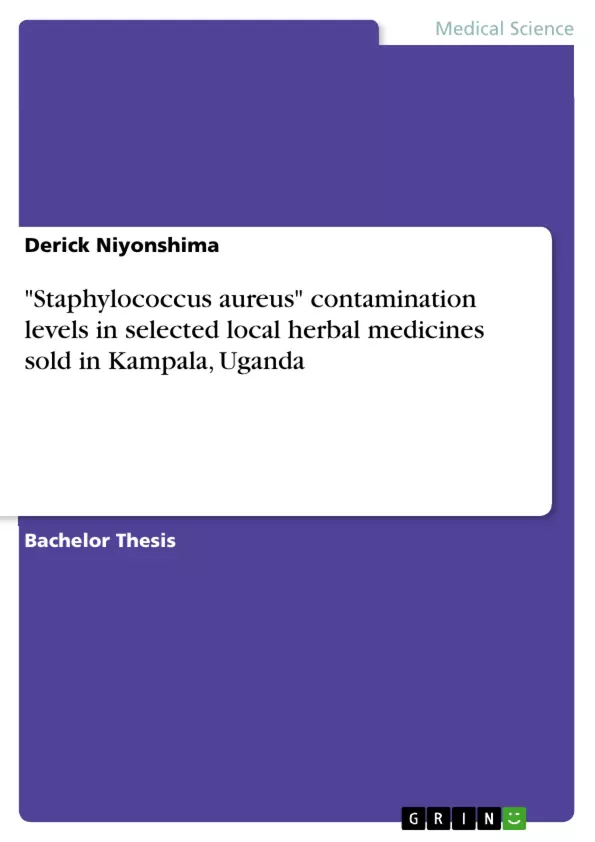Herbal medicine use in Uganda and the world at large is at its peak because of the documented efficacy, effectiveness, cheap cost and less side effects. The estimates of herbal medicine users in the world is 80% and 60% in Uganda, yet with all this demand, less effort has been put to ensure that they are free from bacterial contamination.
The study therefore aimed at determining Staphylococcus aureus contamination of selected liquid herbal medicines sold in Kampala, Uganda with the following specific objectives; to provide an update on the different local herbal medicines sold in Kampala, Uganda and the conditions they treat; to determine Staphylococcus aureus contamination levels of selected liquid local herbal medicines sold in Kampala, Uganda; and to establish the antibacterial susceptibility patterns of isolated Staphylococcus aureus.
A questionnaire was used to collect data on the different local herbal medicines sold in Kampala, Uganda. To determine levels of Staphylococcus aureus contamination, microbial culture was performed on 30 selected liquid herbal medicine samples. In addition Staphylococcus aureus susceptibility patterns were determined by subjecting isolated Staphylococcus aureus species to gentamicin 10μg, chloramphenicol 30 30μg ampicillin 10μg, penicillin 10U and tetracycline 30μg. A total of one hundred and seventy local herbal medicines were identified and classified into twenty five categories basing on conditions they treat.
I therefore recommend that herbal medicines should be tested for bacterial quality by regulatory bodies before being sold to patients to avoid Staphylococcus aureus infection hence avoiding treatment costs. In addition, herbal medicine practitioners should embark on good manufacturing practices to avoid contamination of herbal medicines.
Inhaltsverzeichnis (Table of Contents)
- CHAPTER ONE: INTRODUCTION
- 1.1 Background
- 1.2 Problem statement.
- 1.3 Justification
- 1.4 Study objectives.
- 1.4.1 General objective.......
- 1.4.2 Specific objectives.....
- 1.5 Research questions.
- CHAPTER TWO: LITERATURE REVIEW.
- 2.1 Herbal medicine
- 2.1.1 Classification of herbal medicine
- 2.1.2 Uses of herbal medicine.
- 2.2 Bacterial quality of herbal medicines ……………..\li>
- 2.2.1 Public health complications of contaminated herbal medicine
- 2.3 Biology of Staphylococcus aureus..\li>
- 2.3.1 Transmission of Staphylococcal infections.
- 2.3.2 Diseases caused by Staphylococcus aureus......
- 2.4 Antibacterial resistance.
- 2.4.1 Antibacterial resistance mechanisms of Staphylococcus aureus.....
Zielsetzung und Themenschwerpunkte (Objectives and Key Themes)
This special project report examines the levels of Staphylococcus aureus contamination in selected liquid local herbal medicines sold in Kampala, Uganda. The study aims to determine the extent of bacterial contamination in these medicines and assess the potential public health risks associated with their use. The report also explores the biological characteristics of Staphylococcus aureus, its transmission mechanisms, and the development of antibacterial resistance.
- Staphylococcus aureus contamination in herbal medicines
- Public health implications of contaminated herbal medicines
- Biology and transmission of Staphylococcus aureus
- Antibacterial resistance mechanisms of Staphylococcus aureus
- The role of herbal medicines in healthcare
Zusammenfassung der Kapitel (Chapter Summaries)
Chapter One: Introduction introduces the research topic, problem statement, justification, and study objectives. It provides background information on the use of herbal medicines in Uganda and highlights the potential health risks associated with contaminated products.
Chapter Two: Literature Review delves into the scientific literature related to herbal medicine, the biology of Staphylococcus aureus, and the issue of antibacterial resistance. This chapter examines the classification and uses of herbal medicines, the public health implications of contaminated herbal products, and the transmission of Staphylococcal infections.
Schlüsselwörter (Keywords)
This research focuses on the contamination levels of Staphylococcus aureus in liquid herbal medicines, exploring the public health implications of bacterial contamination. Key themes include herbal medicine, Staphylococcus aureus, antibacterial resistance, public health, and bacterial quality control. The study emphasizes the importance of ensuring the safety and efficacy of herbal medicines.
- Quote paper
- Derick Niyonshima (Author), 2016, "Staphylococcus aureus" contamination levels in selected local herbal medicines sold in Kampala, Uganda, Munich, GRIN Verlag, https://www.grin.com/document/427756



